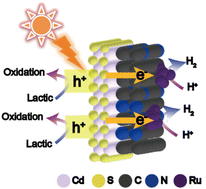Semiconductors are usually employed to construct photocatalysts for hydrogen production, but bare semiconductors often suffer from a high recombination rate of charge carriers, resulting in low activity for proton reduction. Herein, CdS quantum dots (QDs) were anchored onto a tremella-like N-doped carbon (NC) support with trace ruthenium dispersed, to store and consume photo-excited electrons. The Ru/NC cocatalyst significantly enhances the interfacial transfer of electrons and facilitates proton reduction, leading to a decrease in the photoinduced charge recombination. The optimal Ru/NC/CdS-5 catalyst has a low Ru loading of 0.59 wt%, and it exhibits the highest photocatalytic activity with an H2 evolution rate of up to 73.6 mmol g−1 h−1, which is 21 times higher than that of bare CdS QDs (3.38 mmol g−1 h−1). The apparent quantum yield (AQY) of Ru/NC/CdS-5 under the same experimental conditions was found to be 3.6% under irradiation at 420 nm. The catalytic recycling test of Ru/NC/CdS-5 demonstrates its excellent stability. This work provides insight into the enhancement of the activity of semiconductors by dispersing a trace noble metal in a porous carbon support as a cocatalyst for proton reduction.
